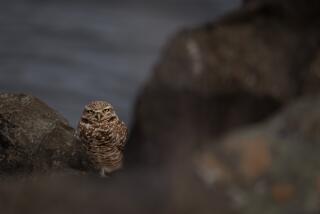Nasty Nesters Give Wing to Scholarship
- Share via
In past years, College of the Canyons officials have sprayed Teflon, nylon and repellents underneath ledges on the concrete campus buildings to discourage thousands of cliff swallows from building nests there each spring.
College maintenance personnel have tried hosing down the ledges with water to stop the swallows from making themselves at home on the classroom buildings. One year, 12 swallows died when their wings stuck together after they landed in a gooey repellent that had been sprayed under a ledge.
But nothing that has been tried so far has kept the birds away. The swallows keep coming back to the College of the Canyons year after year. For the last six years, a lot more swallows have returned to the Valencia campus in mid-March than to the more publicized Mission San Juan Capistrano.
Allowed to Build Nests
This year, at College of the Canyons, the swallows are being left alone to build their nests as they please while a committee of faculty and staff members and students watches. The committee, headed by biology instructor Betty Rose, was formed to turn what has long been viewed as a messy and expensive cleanup problem into a learning experience.
It’s not really an “if you can’t beat them, join them” policy, however, Rose said.
Although many people view the birds as a problem, still others feel the swallows are a real asset to the campus, said college President Ray LaGrandeur, a member of the committee.
“We have the opportunity to involve the students in research--to do a little real biology,” Rose said.
One of the first things the nine-member committee will do is count the swallows to determine if their numbers are increasing or decreasing.
“We felt it was important to know that,” Rose said. “If it is decreasing, we may need to do nothing else about them.”
Prefer Less Urban Spots
The swallows stopped settling at Capistrano after their 6,000-mile journey from central South America because of increasing urbanization around the mission. Rose said the birds found other spots, such as freeway overpasses and college campuses, where mud is more readily available to build their nests.
Swallows, she said, are attracted to concrete structures because they look like cliffs to the birds.
This year, on March 19, the day the birds traditionally return to Capistrano, it was difficult to spot any swallows around the mission. But there were plenty of pigeons on hand.
That may be the case one day at College of the Canyons, Rose said, considering the rapid growth in the Santa Clarita Valley. But, until it happens, the swallows provide students a rare opportunity to learn something about their habits.
“We also need to establish what percentage of the fledglings born here one year can be expected to return as mature adults the following year,” Rose said.
Last year, 576 nesting pairs of swallows produced an average of four or five offspring, she said.
Interested students are observing the birds this semester to accumulate records on them. Many aspects of the swallows’ nesting behavior, mating rituals, migration and social behavior remain unknown, Rose said.
‘Very Social Birds’
“We do know they’re very social birds,” Rose said. “We have a feeling that they may be returning to the same nesting places each year. We just don’t know. There is much we don’t know about the swallows.”
For example, she said, it appears that one bird will give a signal and the rest will follow, leaving their nests to feed. “We’re not sure this happens,” Rose said. “It would be nice to find out for sure.”
Rose and Sue Mouck, also a biology instructor, have applied for a bird-banding permit from the federal Fish and Wildlife Service to help their project. Mouck said the swallows have returned to College of the Canyons for about 14 years.
“It’s only in the last five or six years that anybody’s noticed them,” she said.
The committee will also use its data to develop deterrents and nest-enhancement strategies to lure the swallows from one classroom building to the instructional resources center, commonly referred to as the “I-building.”
Deterrents Considered
Rose said deterrent strategies such as applying a chemical deterrent in thin, six-inch bands under building ledges, installing a fiberglass facade over building corners and placing wire under ledges have been discussed.
“The school has added ledges of plain redwood, wire-covered redwood and concrete-coated planks to the peripheral portions of the I-building where the swallows prefer to nest,” she said. “Nest counting will determine which enhancements the birds prefer.”
Rose said the committee hopes to publish its findings so that other institutions with swallows can benefit from the research.
The committee hopes to establish a swallow sanctuary and pond on the campus.
Biologists in the United States first noticed cliff swallows about 1815, although it is believed they existed here hundreds of years earlier. The birds are five to six inches long, have a square tail and are dark with a light forehead and rust-colored rump and throat.
More to Read
Sign up for Essential California
The most important California stories and recommendations in your inbox every morning.
You may occasionally receive promotional content from the Los Angeles Times.













